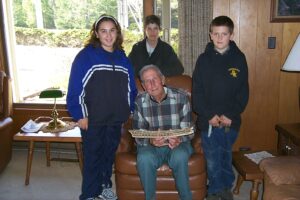Back in 2000, students of Ryan Olson Day’s Options Class at the Mendocino Middle School created an oral history project with the help of Steve Jordan and a grant obtained by Deena Zarlin. They made audio recordings of their interviews with twelve “Old Timers,” who told these children what it was like back in the day. Two decades later, the transcripts of these stories have been pulled from the Kelley House Museum vault, excerpted, and published now for the first time.

Number six in this series finds us at the Mendocino home of Len Peterson on the Comptche-Ukiah Road. He is talking with students Taylor Dines, Carmy Sciaretta, and Steven Lyon. Along for the ride is Steve Jordan and Deena Zarlin.
Len’s story begins in 1919 in San Francisco. Born to Martin and Anna Peterson, an immigrant couple from Sweden, he lived in the Bay Area until 1941, when he went into the Army. His 975th Field Artillery Battalion took part in the Allied invasion of Europe and he came back with several awards for his valiant service.
But he was disillusioned with the rough ways of his hometown, and decided he didn’t want to live there anymore. “I kept looking through the property ads in the papers, and I saw a place with 13 acres in Mendocino, so I decided, maybe I’d give it a look.
“So I came up here on the Greyhound Bus, not having a car, and then I found the real estate fellow here, but the whole place was in nothing but brush, right up to the house, so I really didn’t see much of it here besides the one-room cabin. But I decided that it would be a good move for me, but it’d take an awful lot of work to clean it up. I had no electricity or running water. The only thing I had was a well with a bucket and an old iron wood stove. But I carried on from there, and I lived as a bachelor for about two years until I met my wife, Dorothy.”
Carmy says, “You made the model of the town of Mendocino in 1890, which is at the Ford House Museum on Main Street. Please tell us about that model.” Len tells them how when he was a kid he would build World War I aeroplanes using old Kraft cheese boxes (“the best wood for wings”). Then here in Mendocino, he had built a wooden model of a lumber loading chute that someone liked, and it found its way to the Ford House.
“Then they put the question to me: do you think you could build a model of Mendocino in 1890? And that was quite a project and—after giving a lot of study and procuring me some maps—I went to work on it. But it took me approximately three years and over 2000 hours, but it was very enjoyable doing all the research and all the help I had, so that’s the way it turned out.”
When asked how many buildings are in the Mendocino town model, he says about two hundred, if you count the outhouses. “But something a lot of people don’t know is I used the original dirt form Mendocino for some of the streets.” “Wow! That’s cool!” And Len says, “Yes, I got that sand on my strained real fine and laid it on the streets.”
The children say, “When the Seagull burned down, we understand you helped rebuild it? Tell us about the fire, and how the community came together, to rebuild this.” Len replies, “Well, I wasn’t there when the Seagull burned down, but I was told they could use a lot of help. I’m fairly handy with a hammer and a saw, and I volunteered my help to rebuild it. So, part of the Seagull, whatever it is now, has part of me in it, somewhere.”
Wrapping up their interview, they wonder, “What are some of the biggest changes you’ve seen in the town of Mendocino?” Len recollects his earliest years, before 1960. “Well, it’s grown quite a bit. On Main Street, there used to be on the south side, a small meat shop, run by Joe Quail, and there was a post office there, run by a man called Asa Bishop. We had three stores, another fellow by the name of Bishop, and then there was Homer’s market—right across from the Ford House—and there was Mendosa’s up on Lansing Street. We had two gas stations: one, which was Schlafer’s, and another garage up on Lansing Street, that one was run by Charlie Tyrrell. And there was restaurants, I think; there was two, if I can remember right, but other than that, it was a pretty small town.”
If you would like to hear these recorded voices or read the stories in full, just give us a call at (707) 937-5791 and we’ll set you up for a visit at our research office on Albion Street in Mendocino. Our hours are Friday, Saturday, Sunday, and Monday from 11:00 to 3:00, or email us at curator@kelleyhousemuseum.org.